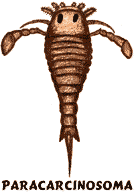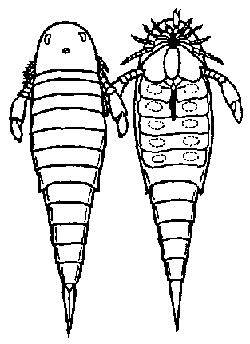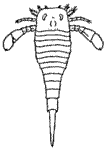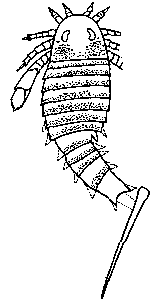Superfamily Eurypteracea

This superfamily includes the "typical" (unmodified) Eurypterids, in which the last prosomal appendages developed as swimming legs that carry paddles formed by expansion of the two penultimate joints.
They can be considered the ancestral lineage from which the other groups evolved.

Hughmilleria norvegia (Kiaer)
length about 10 cm
Pridoli or earliest Lokhovian, Norway
illustration from Treatise on Invertebrate Paleontology
family Hughmilleriidae
 Family Hughmilleriidae Kjellesvig Waering, 1951
Family Hughmilleriidae Kjellesvig Waering, 1951
time range: ?Floian to Frasnian
known distribution: Euramerica
habitat: Marine to Marginal Marine
representative taxa: Hughmilleria norvegia, Hughmilleria bellistriata (Silurian)
description: Hughmilleria is small form which does not differ from the standard Eurypterid body-plan. The prosoma is rounded, with marginal compound eyes. The chelicarae are medium-sized, with small pincers for grasping food, they are like
miniature versions of the large claws of Pterygotus. The body is also similar
to Pterygotus, although the fairly short resembles that of Eurypterus. The metastoma ovate; genital appendage is short and broad in the type "B" form, long and narrow in male.

Eurypterus remipes Dekay
length about 20 cm
Ludlow of Western Euramerica (New York)
illustration from Moore, Lalicker and Fischer, Invertebrate Fossils
family Eurypteridae
 time range:
Darriwilian to Frasnian
time range:
Darriwilian to Frasnian
known distribution: Euramerica , Asia
habitat: Marginal marine and fresh water
representative taxa: Baltoeurypterus tetragonophthalmus (= Eurypterus
fischeri), Eurypterus lacustris, Eurypterus remipes
notes: typical Eurypterids. The body is fairly elongate; the largest species attaining a length of about a meter but most much smaller (average about 20 cm). The prosoma is squared off, the compound eyes kidney-shaped and placed towards the middle of the head, so they look upwards. Between them are two ocelli or simple eyes.

Lepidoderma mansfieldi
Late Carboniferous - length about 12 cm
illustration from Treatise on Invertebrate Paleontology
family Adelophthalmidae
 time range: Llandovery to Artinskian
time range: Llandovery to Artinskian
known distribution: Euramerica , Asia
habitat: Marginal marine, brackish and fresh water; amphibious
representative taxa: Lepidoderma mansfieldi,  Lepidoderma mazonense (both late Carboniferous), Adelophthalmus sellardsi (early Permian),
Lepidoderma mazonense (both late Carboniferous), Adelophthalmus sellardsi (early Permian),
notes: Mostly small forms, similar to Eurypterus but spiny, the outer surfaces with pointed scales and striae; the elongate body equipped with spurs. The postabdomen is narrow and the telson very long (styliform). The compound eyes are located somewhat towards the center of the head. The walking legs are mostly devoid of spines. In Adelophthalmus the
genital appendage of the male is long, of the type "B" form short, with spatulate lateral lobes. These creatures seem to have been semi-aquatic swamp dwellers. They were among the last of the Eurypterids.
Links: Eurypterus
remipes Fauna - Fiddler's Green Formation - Late Silurian - one of the most common eurypterid species is Eurypterus lacustris
images not loading? | error messages? | broken links? | suggestions? | criticism?




 Family Hughmilleriidae Kjellesvig Waering, 1951
Family Hughmilleriidae Kjellesvig Waering, 1951

 time range:
Darriwilian to Frasnian
time range:
Darriwilian to Frasnian

 time range: Llandovery to Artinskian
time range: Llandovery to Artinskian